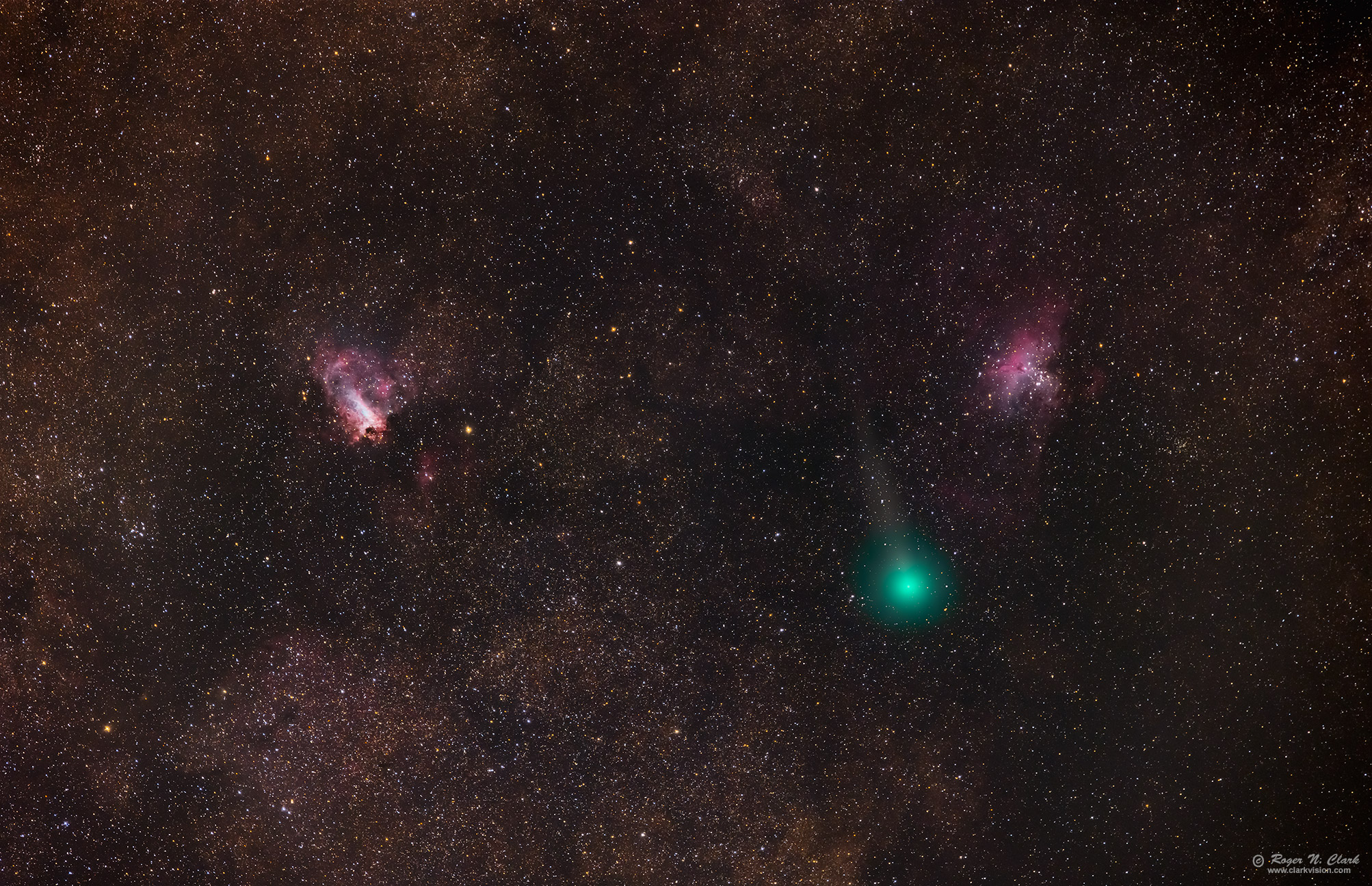| Home | Galleries | Articles | Reviews | Best Gear | New | About | Contact | Gallery Index | Previous |
Next |

| Home | Galleries | Articles | Reviews | Best Gear | New | About | Contact | Gallery Index | Previous |
Next |

Messier 17 (M17) (right), the Swan and Omega Nebula in Sagittarius (pink area in the left), and Messier 16 (M16), the Eagle Nebula in Serpens (pink area on the right) are two prominent nebula in the Milky Way. Passing in between is the green comet Swan C/2025 R2. M17 and M16 are two bright nebulae providing great views in small telescopes. M16 contains the "Pillars of Creation" made famous by Hubble telescope images. They are seen here as the small dark lanes in the center of the nebula. North is to the right. The green color of comet Swan is from emission by diatomic carbon (C2) with possible contribution from cyanogen (CN). A short tail is also visible.
The image is natural color. Star color is close to what we would see with our eyes in telescopes: solar type stars are white, cooler stars yellow to orange and red, and stars hotter than our Sun are bluish-white.
This image was obtained on October 17, 2025. At this time of year in the northern hemisphere, this region of the Milky Way is low in the sky, where atmospheric turbulence and sky glow is stronger, making detections of the faint portions of the nebulae challenging.
Technical. This image was obtained with a stock Canon EOS R5 Mirrorless Digital Camera and Canon 300 mm f/2.8 L IS II lens plus a 1.4x teleconverter giving 420 mm at f/4. Total exposure time was 20 minutes (60 20-second exposures) at ISO 1600. This is a natural color image. Post processing: raw conversion with Photoshop ACR stacking with deep sky stacker on stars, and a second stacking run on the comet with ImagesPlus. Stretched with rnc-color-stretch, and final adjustments in photoshop. No darks, no flats, no bias frames measured (bias is in the camera EXIF data and a flat field is in the ACR lens profile and corrected during raw conversion). Dark current is suppressed. The exposures were tracked on an iOptron HAE29EC strain wave mount with no guiding.
Original plate scale is 2.16 arc-seconds/pixel and this image is shown at about 1/4 resolution 8.6 arc-seconds/pixel.
This is a natural color image.
The Exposure Factors, CEF, CEFA are measures of the relative amounts of light received from a subject. It can be used to fairly compare wildly different lens/telescope apertures and exposure times. For this image on the sky:
Modern digital cameras like the Canon R5 include on sensor dark current suppression technology and low fixed pattern noise at ISOs around 800 and higher, making no need for dark frame subtraction. Modern raw converters correct for light fall-off and also correct for hot/dead/stuck pixels. This makes processing low light images easy: simply align and average.
Also see Astrophotography Image Processing Basic Work Flow.
To learn how to obtain stunning images like this, please visit my Extensive Articles on Photography .
Keywords to this image = astrophoto-1 nebula Messier comet low-light digital_astro canon_r5 rnc-color-stretch NEW
Image ID: comet-swan-2025-10-17-200mm-rnclark-CGS23439-566-av60-h-2006s.jpg
| Home | Galleries | Articles | Reviews | Best Gear | Science | New | About | Contact |
Last updated November 08, 2025